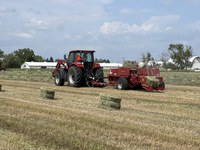Properly curing hay is crucial for forage quality
(Click the image below to view a high-resolution image that can be downloaded)
Weather conditions across the Dakotas have created challenges for haymaking. Properly curing hay to the correct moisture level for baling is crucial to maintaining forage quality. At baling, the moisture level should be a maximum of 20% for small square bales, 18% for round bales and 15% for large square bales. The larger the forage package, the lower the moisture should be at baling.
Exceeding these moisture levels can reduce dry matter and nutrient content of the hay, says James Rogers, North Dakota State University Extension forage crops production specialist. At harvest, hay naturally contains microbial content. Curing limits aerobic microbial growth. Baling hay at moisture levels above 25% creates an environment for aerobic microbial growth to occur. These microbes are living organisms that feed off of the nutrient content of the hay and generate heat. As heat increases, a chemical bond forms between proteins and carbohydrates (maillard reaction), reducing dry matter and digestibility of the end product. Although this reaction produces a more palatable hay, the loss of energy and digestible protein lowers its quality.
Several methods exist to accelerate drying time to prevent moisture-damaged hay. First, if possible, condition the hay at cutting. Conditioning crimps the stem, which hastens moisture loss and speeds drying. Second, when cutting, spread the forage out into as wide a swath as possible. This increases the surface area exposed to sunlight. Third, hay can be inverted or flipped over, or if this is not possible, rake the hay a couple of extra times to get hay moved from the bottom of a windrow to the top. However, be cautious with delicate crops such as alfalfa, as mechanical handling can cause leaf loss.
Using a preservative can also accelerate the time from hay mowing to baling. Preservatives will not lower the moisture content of hay, but they will lower anaerobic microbial growth, decreasing hay heating and thus dry matter and nutrient loss. Preservatives allow baling at a hay moisture content of 25-30%. Beyond 30% moisture, they will not be effective. Baleage is an option for hays with greater than a 30% moisture content. Another important point is that the effect will not last indefinitely. After about 30 days, the effect of a preservative treatment will begin to dissipate. If using a preservative, plan on feeding preserved hay early in the season and avoid storing preserved hay with untreated cured hay.
Three types of preservatives are available: organic acids, ammonia-based and microbial. Anhydrous ammonia is an effective anti-microbial preservative but requires extreme caution in handling and application to avoid personal injury. In addition, it may produce toxicity in high quality hay, potentially causing livestock death. For these reasons, treating high moisture hay with ammonia is not recommended. Microbial products are available, but their effectiveness as a preservative is not supported by research.
Organic acids are reliable, effective and time tested. Propionic acid is the most common of these, and though it is effective, it can be corrosive. Buffers can be mixed with propionic acid to reduce the corrosiveness. Read and follow label directions with propionic acid use as the rates will vary based on moisture content of the hay. Getting good distribution of propionic acid onto the hay is needed to get the most effective treatment. The solution is most often applied at the pickup prior to entering the bale chamber.
Other essential tools include a moisture tester and temperature probe. Various moisture meters are available on the market. It is advisable to check moisture meter accuracy with another method such as the microwave method. A bale temperature probe is useful for monitoring bale temperature when moisture content is suspected to be high until temperatures stabilize. Bale temperatures around 100 degrees Fahrenheit are normal, but if temperatures reach 150 degrees and remain elevated, it signals a problem. The longer a bale stays at an elevated temperature, the more damage will occur.
“Forage testing is always a good management strategy,” says Rogers. “This year when hay may be baled at questionable moisture, forage testing becomes even more important. Knowing available versus unavailable protein and digestibility can make a real difference come this winter.”
For more information, contact your local NDSU Extension county office.
NDSU Agriculture Communication – July 12, 2024
Source: James Rogers, 701-857-7682, james.rogers.1@ndsu.edu
Source: Lacey Quail, 701-857-7677, lacey.quail@ndsu.edu
Source: Karl Hoppe, 701-652-2951, karl.hoppe@ndsu.edu
Editor: Elizabeth Cronin, 701-231-7006, elizabeth.cronin@ndsu.edu


